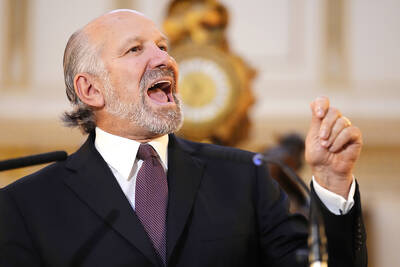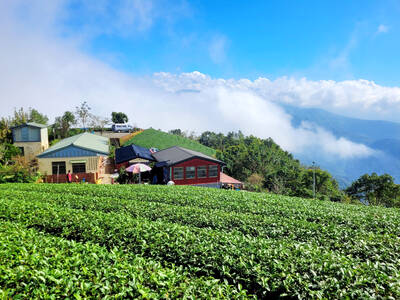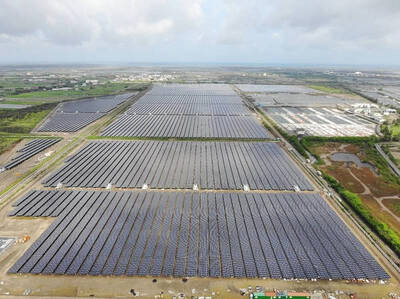Now that Chu Ko Liang (豬哥亮) has been found and made a promising return to showbiz in a television commercial that first screened in April, pundits are engaged in heated debate over the whereabouts of other former stars who retired from the celebrity scene. The ultimate subject of this hunt is Bobby Liu (劉文正), a pop idol who rose to superstardom in 1970s and abruptly hung up his mic in the prime of his career some 27 years ago.
Rumors about his bloated figure and/or death have periodically done the rounds. Veteran singer Yu Ya (尤雅) recently asserted that Liu has gained so much weight over his years in the wilderness that he now looks like Pai Yun (白雲), a blubbery funnyman known for consuming two lunchboxes for every meal.
Infuriated by Yu’s accusation, Liu’s former manager and close friend Hsia Yu-shun (夏玉順) threatened to sue anyone who dares to insinuate that the erstwhile prince of pop is porcine.
So, speculating on the death of a star is fine, but gossiping about his or her weight is beyond the pale.
According to Hsia, Liu, 56, looks as dashing as ever and shows absolutely no interest in making a comeback. “We are not in debt like Chu Ko Liang,” Hsia was quoted as saying.
The Liberty Times [the Taipei Times’ sister paper] reports that the former crooner owns more than 100 properties in the US alone and lives comfortably on his accumulated wealth, which tops US$100 million. The paparazzi face a daunting task catching up with the elusive retiree, as he reportedly has numerous hideaways in Singapore, Malaysia, Las Vegas, Los Angeles and New York City.
Chasing down an A-lister is much easier if you’re a local athlete. They seem to be in vogue these days among the female celebrity clique, partly, commentators say, thanks to the pairing of basketball heartthrob Sam Ho (何守正) and Mando-pop diva A-mei (張惠妹).
Pop star and actress Barbie Hsu (徐熙媛), better known as Big S (大S), Patty Hou (侯佩岑) and top model Patina Lin (林嘉綺) were last week spotted wining and dining at a Japanese barbecue restaurant in Taipei’s East District (東區) with basketball players from Taiwan Beer and the Yulon Dinos at what appeared to be a group blind date.
The presence of China’s Huang Xiaoming (黃曉明), however, hints that the rendezvous might have been a stunt to generate free publicity for his new television soap opera series Summer’s Bubbles (泡沫之夏), which coincidentally costars Big S.
Cynics could also be forgiven for interpreting the latest tidbit on One Million Star (超級星光大道) alumnus Jam Hsiao (蕭敬騰) as a bid to hype the singer’s latest album, which comes out in a few weeks.
After discovering his latent claustrophobia earlier this year, Hsiao began experiencing severe headaches. At a press conference, the star’s manager said the initial diagnosis was worrying and, in the worst-case scenario, the idol might need to have brain surgery.
We all know what happens to stricken celebrities: just think Jade Goody.
A second opinion was sought after a magnetic resonance imaging test, or MRI, at Taipei Veterans General Hospital on Monday. The result: The Hsiao’s unbearable headaches were caused by muscle strain from playing basketball and he requires no serious treatment. Sweet relief.

In recent weeks the Trump Administration has been demanding that Taiwan transfer half of its chip manufacturing to the US. In an interview with NewsNation, US Secretary of Commerce Howard Lutnick said that the US would need 50 percent of domestic chip production to protect Taiwan. He stated, discussing Taiwan’s chip production: “My argument to them was, well, if you have 95 percent, how am I gonna get it to protect you? You’re going to put it on a plane? You’re going to put it on a boat?” The stench of the Trump Administration’s mafia-style notions of “protection” was strong

Every now and then, it’s nice to just point somewhere on a map and head out with no plan. In Taiwan, where convenience reigns, food options are plentiful and people are generally friendly and helpful, this type of trip is that much easier to pull off. One day last November, a spur-of-the-moment day hike in the hills of Chiayi County turned into a surprisingly memorable experience that impressed on me once again how fortunate we all are to call this island home. The scenery I walked through that day — a mix of forest and farms reaching up into the clouds

With one week left until election day, the drama is high in the race for the Chinese Nationalist Party (KMT) chair. The race is still potentially wide open between the three frontrunners. The most accurate poll is done by Apollo Survey & Research Co (艾普羅民調公司), which was conducted a week and a half ago with two-thirds of the respondents party members, who are the only ones eligible to vote. For details on the candidates, check the Oct. 4 edition of this column, “A look at the KMT chair candidates” on page 12. The popular frontrunner was 56-year-old Cheng Li-wun (鄭麗文)

“How China Threatens to Force Taiwan Into a Total Blackout” screamed a Wall Street Journal (WSJ) headline last week, yet another of the endless clickbait examples of the energy threat via blockade that doesn’t exist. Since the headline is recycled, I will recycle the rebuttal: once industrial power demand collapses (there’s a blockade so trade is gone, remember?) “a handful of shops and factories could run for months on coal and renewables, as Ko Yun-ling (柯昀伶) and Chao Chia-wei (趙家緯) pointed out in a piece at Taiwan Insight earlier this year.” Sadly, the existence of these facts will not stop the